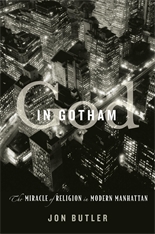The Book
God in Gotham: The Miracle of Religion in Modern Manhattan
The Author(s)
Jon Butler

Butler’s new book has been long awaited, and I’m delighted to report that his usual puckish glee in exploding theories we had taken for granted and inverting arguments we supposed obvious is on full display herein. God in Gotham functions on two levels. On the one hand it is a lively account of religion—which, as Butler usually defines it, means organizations and institutions—in modernizing Manhattan. On the other hand it is a sharp poke in the eye to traditional theories of religion and modernity that should make scholars ask some tough questions.
To the first point. In this book Butler takes on an old cliché; that religion is something for towns and suburbs; cities, cosmopolitan, transient, and technological, are secular. “Religion is not the subject that jumps to mind when thinking about modern Manhattan,” he observes. (3) To be fair, this is a stereotype that scholars of religion have long been dismantling, and Butler throws his shovelful of dirt on the grave of the secularization thesis. One of Butler’s central arguments has to do with how the city became an “engine” rather than a strangler of religion; its diversity and energy and commercial vigor transforming and revitalizing traditional religion. Of course, scholars like Robert Orsi, Wallace Best, and Diane Winston have explored these questions—and particularly with reference to Manhattan. Butler might not be so contrarian here as he presents himself. But he does point out that the city’s varied population, changing industry, and commercial innovations makes it a particularly representative American metropolis, and along with Orsi, Best, Winston and other scholars he observes how American religious people began to translate their faith, reconfigure its practices, and reorder their communities with the tools of the market.
But Butler still brings us much that is new. For one thing, he pushes us to think about that word “religion,” and what it might come to mean in modern environments. Of course, in his classic Awash in a Sea of Faith: Christianizing the American People (1990)—a book to which this present volume stands as a somewhat unofficial sequel—Butler makes the case that historians of American religion have tended to underplay and neglect the importance of institutions, those dull old things like the Federal Council of Churches and Catholic grade schools which nonetheless were and are critical in perpetuating religious identities, communal bonds, and worldviews. In the early twentieth century, Butler contends, “All of the city’s principal religious groups deepened their traditional ritual, theological, and spiritual identities by committing to institutional orders and employing modernity in their service.” (9) Catholics built schools, Protestants home mission societies, Jewish groups “synagogue centers” that featured libraries, clubs, gyms and book groups. These things, Butler argues, were particularly modern responses to modern problems, and thus made religion itself something modern. What Butler means by “modern” remains slightly underdetermined—he quotes Stuart Hall and Matai Calinescu without much extrapolation on the question—but certainly, it means for him a simultaneous diversity and centralization: the rise of bureaucracy and large-scale institutions alongside ever more cultural variety, the technological regularization of society alongside increasing atomization and independence.
In making this argument, in perhaps the most intriguing theoretical move in the book, Butler takes on two of the most venerated names in the study of religion in the United States. “Max Weber and William James,” he observes, “probably would have been surprised by religion’s prosperity, much less survival, in twentieth century Manhattan.” (34) Butler observes that James’s presumptions that the heart and core of religion is personal experiences do not mesh well with the story of ever-larger organizing, institution-building, and routinizing structures that religious groups of all sorts pursued in Manhattan. Similarly, Butler (as with many more recent theorists) believes that Weber understood our regimented and exhaustively documented modern world to smother the improvisational mysticism of religious experience; the charismatic authority of the prophet rendered unable to survive when workers have to report to their supervisors every morning.
But, Butler argues, against both theorists religion is best understood as a collective activity, not a private experience. More than anything else he believes “religion’ is a structure for promoting the adoption of particular identities, narratives, and perhaps indeed experiences—but those individual encounters are inevitably mediated and propagated by other people. Given these arguments, we might see why Butler believes not simply that religion survived in Manhattan, but became most fully what it would be in modern America.
About the Reviewer
Matthew Bowman is associate professor of religion and history at Claremont Graduate University, where he also serves as Howard W. Hunter Chair of Mormon Studies. He is the author most recently of The Abduction of Betty and Barney Hill: Aliens, Civil Rights, and the New Age in America (Yale, 2023) and The Urban Pulpit: New York CIty and the Fate of Liberal Evangelicalism (Oxford, 20140.

0